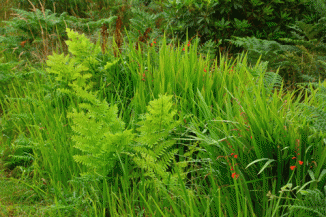Royal Fern is such a distinctive, elegant and imposing species that I doubt anyone would mis-identify it. Not too commonly found in the eastern part of Ireland, it tends to be live in ditches, on boggy ground and damp woodland, favouring peaty soil, where it forms large clumps. It is a stately, erect plant which bears long (200cm+), sterile, bi-pinnate leaves with 5-15 pairs of pinnae or leaflets. In late summer and autumn fertile fronds rise from the middle of the plant and the pinnules of the upper leaves are covered with masses of rusty-brown sporangia which contain spores, the reproductive parts of the plant which, when released are wind-dispersed. This rhizomatous plant dies back in winter. It is our largest native fern and can reach more than 2 metres. This native fern is the only member of the Osmundaceae or Royal Fern family.
I first saw this beautiful plant on a visit to Co Mayo in July 2014. It was growing in the ditch beside a laneway leading to the Greenway cycling and walking route from Westport to Achill. I photographed it at that time.
If you are satisfied you have correctly identified this plant, please submit your sighting to the National Biodiversity Data Centre
According to Nathaniel Colgan in ‘The Flora of the County Dublin’ (1904), Royal Fern was scattered sparsely through Co Dublin but ‘formerly found in Kelly’s Glen, the station is now drained which perhaps accounts for its not being found there now’. First recorded in 1772, it was said to have been ‘observed in the county as early at least as 1740’.
Colgan also wrote ‘This species, so abundant in many parts of west Ireland and generally rare in the east of the island, was probably at no time even frequent in Co. Dublin. Threlkeld* was evidently unable to discover it in the county almost two centuries ago, when it was in request as a sort of catholicon, no less efficacious in disorders of the liver and spleen, than in wounds and bruises and in rickets in children. In the following characteristic passage in his Synopsis, 1727, he complains with some acrimony of the professional reticence of better-informed herbalists: -“I have seen fair Specimens of it among the Herb Folks in John’s Lane, who are loath to discover the Place it grows in for fear of Interlopers who may nim their Profit, Monopolies being natural to self-ended Men”’.
*Caleb Threlkeld (1676-1728) was a ‘dissenting minister born in Cumberland and long settled in Dublin, who laid the foundations of Irish botany in his well-known Synopsis Stirpium Hibernicarum’ which was published in 1727.




